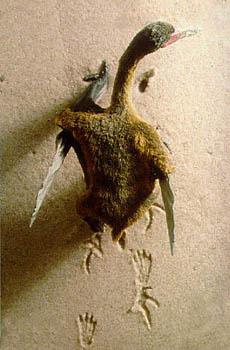|
Bipedal or Quadrupedal Page 3 |
|
|
|
It is likely that Pterosaurs displayed a wide variety of stances and this is reflected in the occurrence in the fossil record of both fused and unfused pelvii. The importance of stance has always been thought to be critical in the interpretation of Pterosaur behavior and locomotive ability; quadrupedal stance was thought to be indicative of ungainly locomotion on the ground, and bipedal stance indicative of superior locomotion. This is probably no longer true, the track ways supporting quadrupedal locomotion indicate that the pterosaur which made them spent a large amount of time on the ground and foraged for food. Whether Pterosaurs were quadrupedal or bipedal is not important when considering the ground locomotive capabilities. Consider the variety of birds and the way in which they move on the ground. The Roadrunner is supremely adapted to running, the loon struggles on land, and vultures waddle ungainly. These same abilities could be reflected in Pterosaurs. |
||
 © Patrick Lyons 1998. |
 Fossilized
track ways have also been found which support the
quadrupedal stance. The problem arrives that it is often
very difficult to associate trace fossils with a particular
organism. The track ways show a wide stance with the hind
legs positioned behind and between the front limbs. The hind
footprints also match perfectly with the bone structure of a
hind foot of a pterosaur. The front limb impressions also
seem to indicate a pterosaur as the originator. The track
ways indicate that the "hand" was rotated forward and that
on the fourth digit the phalange was abnormally long. These
features are all present in pterosaurs. The evidence is far
from being conclusive, in that the hand prints are very
faint.
Fossilized
track ways have also been found which support the
quadrupedal stance. The problem arrives that it is often
very difficult to associate trace fossils with a particular
organism. The track ways show a wide stance with the hind
legs positioned behind and between the front limbs. The hind
footprints also match perfectly with the bone structure of a
hind foot of a pterosaur. The front limb impressions also
seem to indicate a pterosaur as the originator. The track
ways indicate that the "hand" was rotated forward and that
on the fourth digit the phalange was abnormally long. These
features are all present in pterosaurs. The evidence is far
from being conclusive, in that the hand prints are very
faint.